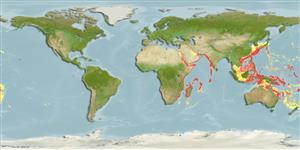Common names from other countries
Environment: milieu / climate zone / depth range / distribution range
Ecología
Pelágico; rango de profundidad 0 - 1280 m (Ref. 108316). Subtropical
Distribución
Países | Áreas FAO | Ecosistemas | Ocurrencias, apariciones | Introducciones
Indo-West Pacific.
Length at first maturity / Tamaño / Peso / Age
Maturity: Lm ? range ? - ? cm
Life cycle and mating behavior
Madurez | Reproducción | Puesta | Huevos | Fecundidad | Larva
Members of the subclass Copepoda are gonochoric and sexually dimorphic. During copulation, male glues spermatophores to the female's venter. Life cycle: Eggs undergo six naupliar and five larval stages before becoming an adult.
Jia, X., Z. Li, C. Li, Y. Qiu and J. Gan. 2004. (Ref. 75930)
IUCN Red List Status (Ref. 130435)
CITES status (Ref. 108899)
Not Evaluated
Not Evaluated
Human uses
| FishSource |
Herramientas
Más información
Age/Size
Crecimiento
Length-weight
Length-length
Morfología
Larva
Abundancia
Fuentes de Internet
Estimates based on models
Preferred temperature
(Ref.
115969): 8 - 19.6, mean 11.7 (based on 348 cells).
Price category
Unknown.
